If you know British engine designer Cosworth, you know that its engines powered Formula One cars raced by Lotus, Ford, March, McLaren, Jaguar, Lola – the list is exhaustive, as are its championships. In 1969, for instance, Cosworth-powered cars won every single Grand Prix. But if you know the Chevrolet Vega, you are probably already cursing about some horrific personal affront dished out by this sewage rat of a car. Perhaps a warped head? Rust in the crannies of every nook? And yet after an overlong gestation, John DeLorean mashed the sublime and the ridiculous together, producing the Cosworth Vega. Arriving too late to rescue the Vega from its reputation, and costing too much, while also being less powerful than expected, the Cosworth Vega struggled to gain traction. The car was made only over the 1975-1976 model years in a handful of thousands – a vanishingly small number compared to most American iron. Consequently, this robust iteration of the Vega is gaining favor with collectors. If you hanker for an example of this rarity, here on craigslist is a 1975 Cosworth Vega, with an asking price of $12,500. The car can be driven home from Swansea, Missouri. Thanks to Barn Finder Pat L. for this “worthy” tip!
Cosworth built an engine based on the Vega aluminum block – a 2.0-liter twin-cam four-cylinder. Equipped with Bendix fuel injection, the engine generates about 110 hp. It’s not torquey and it’s not very fast. This example has 67,000 miles on the odometer, and many of the consumables have been changed, including plugs, belts, hoses, and filters. The car has new fuel pumps, injector seals, battery, windshield washer pump, even a new radiator. The gas tank has been cleaned and sealed. The tires are fresh, installed on refinished wheels. This car is equipped with the optional positraction rear end.
The interior photos are limited, with no views of the dash. The seats look fine and the rear cargo area is very clean. The seller notes that the door seals, hatchback seal, and exterior decals are new. The “Vega” badge on the front hood along with the paint in that region shows wear. In 1975, the Cosworth Vega sported a “John Player Special-esque” paint job, harkening back to “you can have any color you want so long as it is black”. In its final year, eight other colors were available.
This car comes with its original purchase order, owner’s manual, service booklet, and the engine technician’s signed engine seal. I wish the listing told us more of the history of this particular owner with this particular car because I suspect it would be a salutary tale attractive to prospective buyers. Meanwhile, if this car is half the quality it appears, it may be underpriced. This example sold for $28,600, and here’s one at $24,200. Do any of you Barn Finders have experience with the Cosworth Vega?



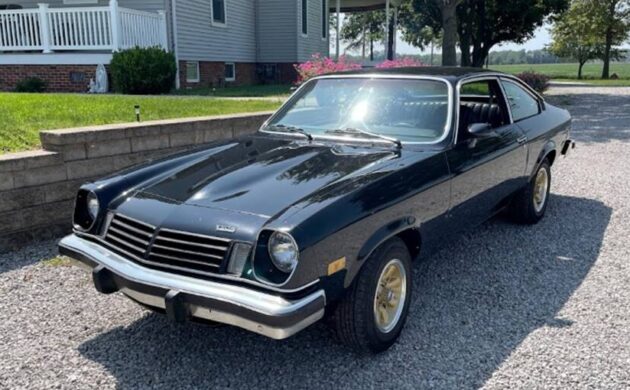
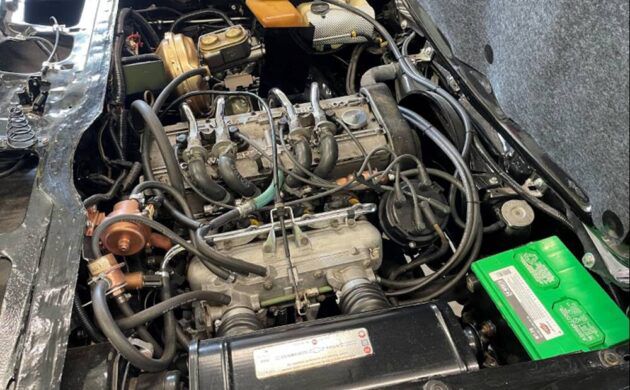
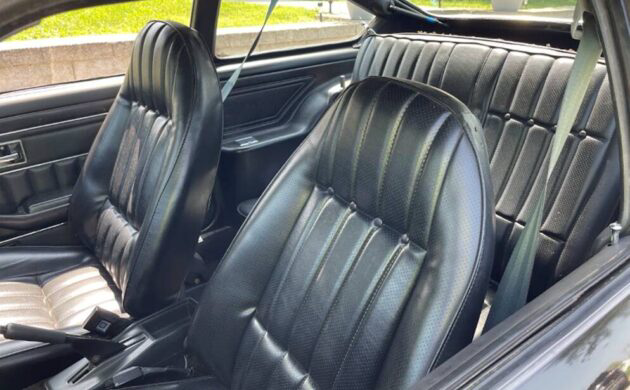

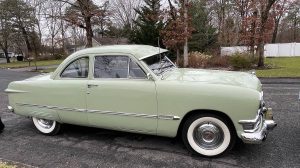
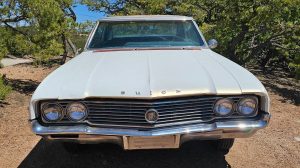
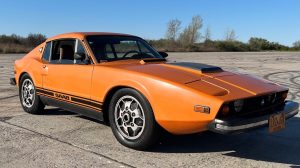
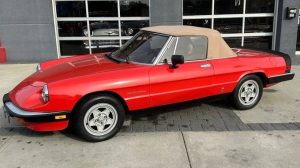


Is it an interference motor?
No.
This thing seems to be making its rounds.
When these were released they completed with the Corvette roadster and Caprice convertible and Estate wagon in price as the most expensive Chevys that year. A staff writer for the Detroit News wrote in reference to the 100 mpg speedometer that this was the first Vega that could attain that speed.
“100 mpg Speedometer”? Really? Obviously a typo, but I wish this site had an “Edit” feature, to allow posters to make corrections like that after you post a comment, to prevent smart asses like me from giving the less nimble-fingered among us a hard time, LOL! I’ve been guilty of the occasional typo myself, and often wished for the ability to correct a post after the fact, to correct something I missed when proof reading my copy after I put it up!
Mpg speedometer????
So, nobody has ever noticed that g and h are next to one another? The grammar police will be pulling you over one day too. lol
“Internet canon says the Vega was one of the worst cars ever made. Well, it certainly had its issues, and it assuredly qualifies as one of GM’s Deadly Sins because of the corporate decisions that resulted in its failures. But other cars from the 1970s (domestics and imports) rusted out and blew head gaskets, too. By 1975-76, Vega was a reliable and durable car when compared to other domestic offerings, and the later models get painted (unfairly IMO) with perhaps too broad a negative brush. The Cosworth variant’s huge potential was ultimately frittered away by the same brand of poor corporate decision making. By the time it finally (finally!) came to market, hobbled as it was by an unrealistic price tag, the market and car culture had moved on and it was effectively irrelevant.”
My own summary in a history of the development of the CV I wrote for Curbside Classic a few years back. My first car was a ’71 notchback and I bookended that with a ’76 CV (dash #2196) for about two years before I retired – autocrossed it several times as that’s how the PO had set it up. It was a hoot on the track, but was otherwise a crude vehicle, although that must be put in the context that this is what ‘economy’ cars were in the 1970s. It was dead reliable in the two years I owned it, however – the only failure I had was a starter solenoid, and AutoZone had a replacement on the shelf.
The Cosworth Vega was a classic example of unfulfilled promises from GM, even though some of those shortcomings weren’t entirely GM’s fault. It needed about fifty horsepower (50 hp) more to justify the lofty $5000 price tag, but with more power and an Independent Rear Suspension (IRS) setup, it could have been a world beater! I think that Detroit held on to the live axle rear end for about thirty (30) years past its prime, but to be fair, they had all of those Government mandates to deal with, but the new rules didn’t stop VW and the Japanese. I don’t know why it took so long for Detroit to get with the program and catch up to the foreign competition, but it did.
The Vega was developed at a time when the ¥ was being held to artificially low levels to keep the prices of their exported cars low in the US market
Cutting costs to meet the Japanese on price is one of the things that destroyed the Vega. They cut too much.
John Z DeLorean head wanted to market the Vega as a “premium” small car, with higher content and quality, but was voted down
I don’t think that meeting the cost of government regulations was a big part of the problem, because Toyota, VW, Ford and all competition, domestic and foreign had to meet the same regulations
After four years of using customers as test pilots for its under developed Vega, by 1975 the car was sort of OK
of course other cars, rusted and blue head gaskets but none with the alarming frequency of the Chevrolet Vega.
Mine blew its head gasket around 11,000 miles, and began resting immediately requiring removal of the windshield and backlight to repair rust within one year of ownership.
while it could’ve been a contender, a General Motors cost department, make sure that the body with rest of it’s almost as quickly as the aluminum engine self-destructed due to an inadequate cooling system
probably the worst car in history, and even the worst consumer product ever sold
Polishing this bit of excrement with a Cosworth head was ridiculous feudal exercise that produce the car that was almost as expensive as a Corvette without air-conditioning and marginal performance improvements
I had a 76 Cosworth Vega in blue and gold that I paid $300 for. I wasn’t in running condition, but 95% complete…I traded it for a 74 Capri race car which I traded for something else. There is a Cosworth Vega Owners Club if you need parts.
Engine output was throttled way back from what was intended, but at the time there weren’t very many new cars that could outperform it in the San Francisco bay area hills. Corvettes would struggle trying to keep up on smooth twisty roads.
I put 90,000 miles on mine and other than replacing a couple clutch cables, and for some reason needing to tighten down the head a couple times, it was trouble free during my ownership.
Meanwhile where I am from, which has nothing but straight, flat, smooth roads, the Corvette was the car to have.
Where you live really can make you love or hate an entire class of car. I personally cannot stand small, tinker toy cars that handle well because…. I will never turn more than 6 times in an average trip.
I’d much rather have the boats you Californian Valley people loathed because, well, we have no valleys, no canyons, and I’m totally cool with it.. lived in Colorado and made many, many trips into the mountains and you can keep your sheer drops and blind curves.
It’s sad that an entire class of car (Boats and Yachts) have disappeared because everyone needs a Canyon Carver.
Yes, these cars were way overpriced when new, and changes required to meet the latest emissions standards of the time sapped most of the power, but these cars are historically significant and worthy of preservation! Unlike a previous example on Barn Finds that had its pedigree destroyed by having its Cosworth motor removed and replaced with a V8, this one appears to be all original. The Cosworth Vega was the first production all-aluminum, multi-valve engine with both fuel injection and electronic ignition, and that what makes it special! It is the ancestor for all of the GM four-cylinder engines that would follow it, and the configuration it used is now as common as dirt, but this one was the first, and the first always has special historical interest.
I own CV#2013 (a late 1975 mode). As others have mentioned, these are indeed fairly well made (comparable to Toyota quality at the time), and are a very fun to drive car.
As for the the 110hp. Let’s put that into perspective. First of all, the car weighs 2700lbs. Most 4000 lb land yachts of the time had 140-150hp. A BMW 2002 (not a tii) had 98 in 1975. The thing that actually brought these engines down from the 150-170 net that was promised, was the catalytic converter. These cars were supposed to be released in 1973, then again in 1974 (both prior to converters). The CV’s engine has considerable valve duration and really only wakes up at 4000rpm. The 15 psi of back pressure in the exhaust (mostly from the converter), at those high rpm kill the top end. Remove the converter and your 150hp is back. A pair of Weber side drafts (actually this is how the prototypes were built), adds about another 10-15 hp.
The real thing with these cars is the technology that they had for their day. The few DOHC engines that existed at the time (mostly Italian) we still 2 valve/cylinder engines. This was a true 4 valve engine (Formula 1/2 technology at the time), and also one of the absolute first sequential fuel injected engines that used electronic controls (Bosch D-Jet was not sequential). The engines were hand built in a lab. There is a reason these cost $6000 in their day. Again, with some perspective, a BMW 2002 was an $8000 car then, and no less spartan.
While everyone enjoys blaming omissions equipment, the problem falls squarely on the limits of the aluminum block.
To get the kind of power they wanted, Cosworth wanted GM to reinforce the block.
GM refused to do this, so the limitations of the basic Vega 2300 aluminum block compromised power and reliability
The racing version of the engine (yes these were raced in F2), had 12:1 compression. These blocks had issues with the tops of the block sometimes cracking the and separating. This was particular to the racing engine only. That said, these were quite dominant in F2 from 1970-1973. It was determined that if the compression was kept to less than 11:1, this issue did not take place. It was never an issue with the street engine.
Also, the aluminum block was never an issue in of itself for even the basic Vega. The issue (with the basic Vega), was the cost-cutting decision to use a cast iron head. As anyone knows from high school chemistry, metals have different expansion rates at a given temperature. The early Vegas were not cooled adequately to deal with this disparity (small radiator, radiator too low relative to engine placement, no overflow) that these cars ended up suffering from first order overheating issues and second order silicon erosion in the cylinders. Tbe Cosworth used a Cosworth aluminum head so this entire issue was moot.
As for the emissions gear, these cars actually had very little. They had no EGR, no CCS, TCS, etc. The fuel injection kept these cars clean enough to pass 1975 standards without it. The decision to use a catalytic converter and pulse air injection system was actually done to keep these cars 50 state emissions legal (they were literally the only GM car that came in a single emissions configuration and were also the cleanest car the EPA had tested until that time). As we all know, 1975 was the first year the catalytic converter was used and on this particular engine (due to its very high rpm design) was a major source of exhaust back pressure at those high rpm. Simple math (HP=torque x rpm/5252) means that anything that limits the engines rpm (such as the 15 psi of back pressure the catalyst introduced) would kill the top end. These cars went from 140 hp net in 1974 (with 8 degrees of timing advance), to 110 in final configuration with converter and another 4 degrees of static advance added back in.
The racing engines has 12:1 compression. These were raced and were the engines with the issues of the blocks cracking. When they held together they actually won quite a few F2 races. These made 270 HP.
The street engine never had such issues.
The aluminum block was actually not the core issue for the Vega. Using a cast iron head and not adequately cooling the disparate metals was. This issue is moot on a Cosworth.
JasonV.
I don’t think that the major problem with the Vega block was because of a cast iron head.
The problem was an inadequate cooling system. The nickasil alloy only is hard enough to resist pistons scraping against the aluminum cylinder walls in a very narrow range of temperatures.
The two pass radiator supplied could not do this, causing pistons to rub on soft bear aluminum leading to premature wear
gazillions of motors have been built with aluminum heads and cast-iron blocks without any problems at all. Notable examples include the incredible Lampredi DOHC Fiat engine
my understanding is the biggest problem with the aluminum head. Where is it? Made the engine quite top-heavy and introduced serious vibrations into the drivetrain.
Looks like a decent Vega. I just can’t get past old memories of how terrible Vegas were back in the day, no matter what engine powers it. That radiator support looks kind of wavy to me, which makes me wonder if this car had front end damage at some point. I’d definitely want to put eyes on it before bidding.
I’m a Ford guy (there’s no known cure). Back in the day I had a ‘74 Pinto with a mildly tweaked 2.3L. I could beat any other (stock) Pinto or Vega. Then one day I unknowingly passed a Cosworth Vega. I’ll never forget the scream from that engine as something flashed past me. I caught him at the next town/stoplight and figured out what happened. Very cool and historic car!
I bought a 1975 Vega station wagon with 11,000 miles on it in 1976 from an “older” neighbor. I was very nervous about the purchase after all the bad press I had read but, it was all I could afford and the old gentleman was giving me a deal. I three years I put over 100k miles on it and only had a problem with the starter solenoid(several). I really began to enjoy the car for it’s mpg’s and even the handling! I had a hard time selling it in 1978 (nobody wanted it) but it ran well and was clean when I got rid of it.
Would I buy another one? I’d like to say I would but how many times can you get lucky like that?
everyone I know who bought a 1975 or later Vega with the radically revised “Durabuilt 140” engine was happy with their car.
those lucky people got a car with an adequate radiator, a revised head with superior Cooling, and the stainless steel head gasket originally specified, but deleted by cost cutters
those I know who bought 1971 and 72 cars are mostly still in therapy
The experience of an early Vega owner, and a late Vega owner are not comparable
MIne was a 75. I loved it. Yea it burned oil but oil was 33 cents/qt. Big deal. I took community college classes in 1985 where I re-sleaved the block and did the body work and paint. That was my baby until 1993 when I got sideswiped by some guy running a red light in DC.
Very cool cars. Jerk that Cosworth(less) engine out, put in a crate 350 with a turoglide transmission in, then let the sparks fly.
That’s the way to do it. I had a ’75 GT Wagon that I put a snotty 327 Dual Quad , M22 and a narrowed 12 Bolt posi. That car was a hoot to drive. I’d love to build another with an LS in it.
Another guy who wants to destroy a piece of history just to make another boy racer mobile! If you want to do that to a regular Vega, fine, go right ahead, but PLEASE, save these rare birds for what they are! This was GM’s first all-aluminum, multi-valve DOHC engine with both electronic ignition AND sequential multi-port fuel injection! The only made about 5000 examples over two years, the Cosworth option is worthy of preservation! Now, those features are as common as dirt, but this one was the first! Nobody remembers who was the second crew to land on the Moon ( Captain Charles “Pete” Conrad, USN and Captain Alan Bean,USN, on Apollo 12), but we ALL know who was first! It’s only original once! Please don’t destroy a piece of history! “Those who fail to learn from history are condemned to repeat it!”
They only made that many because it’s all they could sell
The majority of motors went straight to recycling, where they belonged
note to Detroit: putting an expensive head on a crap motor is stupid. It didn’t work better on the Chrysler TC, either.
Alfa Romeo was building all aluminum twin cam engines in 1925
Fuel injection was a nice touch on the Cosworth, but I’m not sure it was a major engineering advance
but as middling as these cars, work, to put any other engine in one would really be a waste. Go buy a regular Vega if you can find one that hasn’t rusted out.
well, that destroys any value, it might’ve had as a collector car, but have at it
I have never seen one in any color other than black, didn’t know they offered other colors. There was one that languished on a used car lot about 30 years ago priced at about $3500 if I recall. Nobody would touch it at that price then (though adjusted for inflation the subject car here is probably cheaper.
All 1975 cars are black. About 50% of the 1976 cars were other colors. Some are single digit rare.